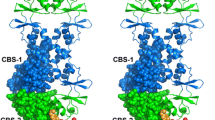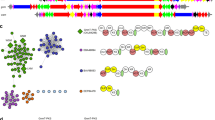Abstract
Mimosinase degrades the non-protein amino acid mimosine and is thought to have evolved from cystathionine β-lyase (CBL) via gene duplication. However, no study has, to date, compared the molecular characteristics of mimosinase and CBL. We therefore cloned mimosinase and CBL from the Mimosoideae subfamily member Mimosa pudica (Mp) and explored the molecular relationship between mimosinase and CBL for the first time. The recombinant Mp mimosinase degraded both mimosine and cystathionine with a much higher turnover number (kcat) for mimosine compared with cystathionine, and Mp CBL utilized only cystathionine as a substrate. The critical residues implicated in the substrate binding of Arabidopsis thaliana CBL (Tyr-127, Arg-129, Tyr-181, and Arg-440) were highly conserved in both Mp mimosinase and CBL. However, homology modeling and molecular simulation of these enzymes predicted variations in the residues that interact with substrates. A mutation experiment on Mp mimosinase revealed that the disruption of a disulfide bond in the vicinity of the pyridoxal-5′-phosphate domain increased the enzyme’s preference toward cystathionine. Treatment of Mp mimosinase with a disulfide-cleavage agent also decreased mimosinase activity. Furthermore, mutation near the conserved binding residue altered the substrate preference between mimosine and cystathionine. Molecular dynamics simulations of Mp mimosinase suggested a closer coordination of the residues that interact with mimosine at the active site compared with cystathionine, indicating a more compact pocket size for mimosine degradation. This study thus may provide new insights into the molecular diversification of CBL, a C–S lyase, into the C–N lyase mimosinase in the Mimosoideae subfamily.










Similar content being viewed by others
References
Alexander FW, Sandmeier E, Mehta PK, Christen P (1994) Evolutionary relationships among pyridoxal-5′-phosphate-dependent enzymes. Regio-specific alpha, beta and gamma families. Eur J Biochem 219:953–960
Breitinger U, Clausen T, Ehlert S, Huber R, Laber B, Schmidt F, Pohl E, Messerschmidt A (2001) The three-dimensional structure of cystathionine beta-lyase from Arabidopsis and its substrate specificity. Plant Physiol 126:631–642
Chai TT, Ooh KF, Ooi PW, Chue PS, Wong FC (2013) Leucaena leucocephala leachate compromised membrane integrity, respiration and antioxidative defence of water hyacinth leaf tissues. Bot Stud 54:8. https://doi.org/10.1186/1999-3110-54-8
Chang L (1960) The effect of mimosine on alkaline phosphatase of mouse kidney. J Formos Med Assoc 59:108–114
Chou CH, Kuo YL (1986) Allelopathic research of subtropical vegetation in Taiwan: III. Allelopathic exclusion of understory by Leucaena leucocephala (Lam.) de Wit. J Chem Ecol 12:1431–1448. https://doi.org/10.1007/BF01012362
Crounse RG, Maxwell JD, Blank H (1962) Inhibition of growth of hair by mimosine. Nature 194:694–695
Dai Y, Gold B, Vishwanatha JK, Rhode SL (1994) Mimosine inhibits viral DNA synthesis through ribonucleotide reductase. Virology 205:210–216
Dewreede S, Wayman O (1970) Effect of mimosine on the rat fetus. Teratology 3:21–27
Dong Z, Arnold RJ, Yang Y, Park MH, Hrncirova P, Mechref Y, Novotny MV, Zhang JT (2005) Modulation of differentiation-related gene 1 expression by cell cycle blocker mimosine, revealed by proteomic analysis. Mol Cell Proteom 4:993–1001. https://doi.org/10.1074/mcp.M500044-MCP200
Droux M, Ravanel S, Douce R (1995) Methionine biosynthesis in higher plants. II. Purification and characterization of cystathionine beta-lyase from spinach chloroplasts. Arch Biochem Biophys 316:585–595. https://doi.org/10.1006/abbi.1995.1078
Felsenstein J (1985) Confidence limits on phylogenies: an approach using the bootstrap. Evolution 39:783–791
Hallak M, Vazana L, Shpilberg O, Levy I, Mazar J, Nathan I (2008) A molecular mechanism for mimosine-induced apoptosis involving oxidative stress and mitochondrial activation. Apoptosis 13:147–155. https://doi.org/10.1007/s10495-007-0156-7
Hamilton R, Donaldson L, Lambourne L (1968) Enlarged thyroid glands in calves born to heifers fed a sole diet of Levcaena leucocephala. Aust Vet J 44:484
Hashiguchi H, Takahashi H (1977) Inhibition of two copper-containing enzymes, tyrosinase and dopamine β-hydroxylase, by l-mimosine. Mol Pharmacol 13:362–367
Hylin JW (1969) Toxic peptides and amino acids in foods and feeds. J Agric Food Chem 17:492–496. https://doi.org/10.1021/jf60163a003
Ishikawa T, Kuwata K (2009) Fragment molecular orbital calculation using the RI-MP2 method. Chem Phys Lett 474:195–198
Ishikawa T, Ishikura T, Kuwata K (2009) Theoretical study of the prion protein based on the fragment molecular orbital method. J Comput Chem 30:2594–2601
Jones RJ, Megarrity RG (1986) Successful transfer of DHP-degrading bacteria from Hawaiian goats to Australian ruminants to overcome the toxicity of Leucaena. Aust Vet J 63:259–262
Jones R, Blunt C, Holmes J (1976) Enlarged thyroid glands in cattle grazing leucaena pastures. Trop Grassl 10:113–116
Joshi H (1968) The effect of feeding on Leucaena leucocephala (Lam) de Wit. on reproduction in rats. Aust J Agric Res 19:341–352
Kitaura K, Ikeo E, Asada T, Nakano T, Uebayasi M (1999a) Fragment molecular orbital method: an approximate computational method for large molecules. Chem Phys Lett 313:701–706
Kitaura K, Sawai T, Asada T, Nakano T, Uebayasi M (1999b) Pair interaction molecular orbital method: an approximate computational method for molecular interactions. Chem Phys Lett 312:319–324
Kumar S, Stecher G, Tamura K (2016) MEGA7: molecular evolutionary genetics analysis version 7.0 for bigger datasets. Mol Biol Evol 33:1870–1874
Lalande M (1990) A reversible arrest point in the late G1 phase of the mammalian cell cycle. Exp Cell Res 186:332–339
Li XW, Hu CP, Li YJ, Gao YX, Wang XM, Yang JR (2015) Inhibitory effect of l-mimosine on bleomycin-induced pulmonary fibrosis in rats: role of eIF3a and p27. Int Immunopharmacol 27:53–64. https://doi.org/10.1016/j.intimp.2015.04.048
Lin J, Shih Y, Ling K (1962) Studies on the mechanism of toxicity of mimosine (β-(N-[3-hydroxypyridone])-α-aminopropionic acid). 1. Studies of the reactions of mimosine and pyridoxal 5-phosphate using the spectrophotometric method. J Formos Med Assoc 61:997–1003
Lin J, Kuang T, Ling K (1963) Studies on the mechanism of toxicity of mimosine III. The effect of mimosine on the activity of l-dopa decarboxylase, in vitro. J Formos Med Assoc 62:587–592
McGilvray D, Umbarger HE (1974) Regulation of transaminase C synthesis in Escherichia coli: conditional leucine auxotrophy. J Bacteriol 120:715–723
Morris GM, Huey R, Lindstrom W, Sanner MF, Belew RK, Goodsell DS, Olson AJ (2009) AutoDock4 and AutoDockTools4: automated docking with selective receptor flexibility. J Comput Chem 30:2785–2791. https://doi.org/10.1002/jcc.21256
Negi VS, Bingham JP, Li QX, Borthakur D (2013) midD-encoded ‘rhizomimosinase’ from Rhizobium sp. strain TAL1145 is a C–N lyase that catabolizes l-mimosine into 3-hydroxy-4-pyridone, pyruvate and ammonia. Amino Acids 44:1537–1547. https://doi.org/10.1007/s00726-013-1479-z
Negi VS, Bingham JP, Li QX, Borthakur D (2014) A carbon-nitrogen lyase from Leucaena leucocephala catalyzes the first step of mimosine degradation. Plant Physiol 164:922–934. https://doi.org/10.1104/pp.113.230870
Qi X, Li MW, Xie M, Liu X, Ni M, Shao G, Song C, Kay-Yuen Yim A, Tao Y, Wong FL, Isobe S, Wong CF, Wong KS, Xu C, Li C, Wang Y, Guan R, Sun F, Fan G, Xiao Z, Zhou F, Phang TH, Liu X, Tong SW, Chan TF, Yiu SM, Tabata S, Wang J, Xu X, Lam HM (2014) Identification of a novel salt tolerance gene in wild soybean by whole-genome sequencing. Nat Commun 5:4340. https://doi.org/10.1038/ncomms5340
Qiao S, Murakami K, Zhao Q, Wang B, Seo H, Yamashita H, Li X, Iwamoto T, Ichihara M, Yoshino M (2012) Mimosine-induced apoptosis in C6 glioma cells requires the release of mitochondria-derived reactive oxygen species and p38, JNK activation. Neurochem Res 37:417–427. https://doi.org/10.1007/s11064-011-0628-6
Rashid MH, Iwasaki H, Parveen S, Oogai S, Fukuta M, Hossain MA, Anai T, Oku H (2018) Cytosolic cysteine synthase switch cysteine and mimosine production in Leucaena leucocephala. Appl Biochem Biotechnol 186:613–632. https://doi.org/10.1007/s12010-018-2745-z
Ravanel S, Ruffet ML, Douce R (1995) Cloning of an Arabidopsis thaliana cDNA encoding cystathionine beta-lyase by functional complementation in Escherichia coli. Plant Mol Biol 29:875–882
Reis P, Tunks D, Hegarty M (1975) Fate of mimosine administered orally to sheep and its effectiveness as a defleecing agent. Aust J Biol Sci 28:495–502
Smith I, Fowden L (1966) A study of mimosine toxicity in plants. J Exp Bot 17:750–761
Soedarjo M, Hemscheidt TK, Borthakur D (1994) Mimosine, a toxin present in leguminous trees (Leucaena spp.), induces a mimosine-degrading enzyme activity in some rhizobium strains. Appl Environ Microbiol 60:4268–4272
Suda S (1960) On the physiological properties of mimosine. Bot Mag Tokyo 73:142–147
Tamura K, Battistuzzi FU, Billing-Ross P, Murillo O, Filipski A, Kumar S (2012) Estimating divergence times in large molecular phylogenies. Proc Natl Acad Sci USA 109:19333–19338. https://doi.org/10.1073/pnas.1213199109
Tangendjaja B, Lowry J, Wills R (1986) Isolation of a mimosine degrading enzyme from leucaena leaf. J Sci Food Agric 37:523–526
Vimolmangkang S, Deng X, Owiti A, Meelaph T, Ogutu C, Han Y (2016) Evolutionary origin of the NCSI gene subfamily encoding norcoclaurine synthase is associated with the biosynthesis of benzylisoquinoline alkaloids in plants. Sci Rep 6:26323. https://doi.org/10.1038/srep26323
Wu YH, Li XW, Li WQ, Li XH, Li YJ, Hu GY, Liu ZQ, Li D (2016) Fluorofenidone attenuates bleomycin-induced pulmonary fibrosis by inhibiting eukaryotic translation initiation factor 3a (eIF3a) in rats. Eur J Pharmacol 773:42–50. https://doi.org/10.1016/j.ejphar.2016.01.006
Xuan T, Elzaawely A, Deba F, Fukuta M, Tawata S (2006) Mimosine in Leucaena as a potent bio-herbicide. Agron Sustain Dev 26:89–97
Acknowledgements
We thank Dr. Madhugiri Nageswara-Rao and Professor Donovan Baily of the New Mexico State University for providing transcriptomic analysis data for Leucaena leucocephala.
Author information
Authors and Affiliations
Corresponding author
Additional information
Publisher's Note
Springer Nature remains neutral with regard to jurisdictional claims in published maps and institutional affiliations.
Electronic supplementary material
Below is the link to the electronic supplementary material.
Rights and permissions
About this article
Cite this article
Oogai, S., Fukuta, M., Watanabe, K. et al. Molecular characterization of mimosinase and cystathionine β-lyase in the Mimosoideae subfamily member Mimosa pudica. J Plant Res 132, 667–680 (2019). https://doi.org/10.1007/s10265-019-01128-4
Received:
Accepted:
Published:
Issue Date:
DOI: https://doi.org/10.1007/s10265-019-01128-4




